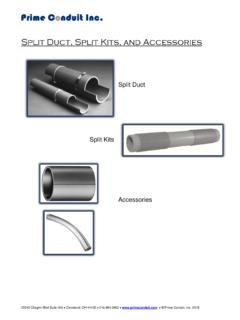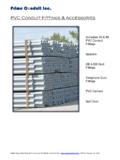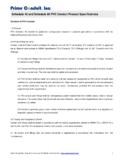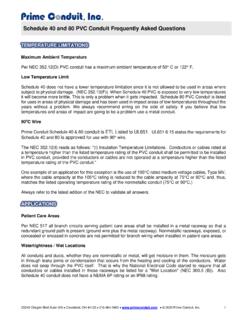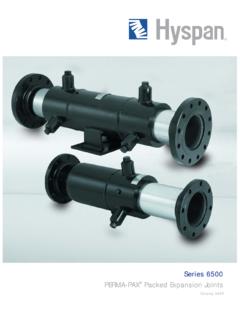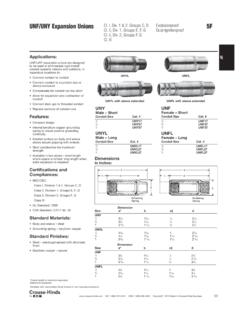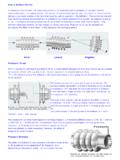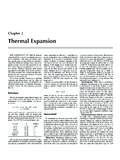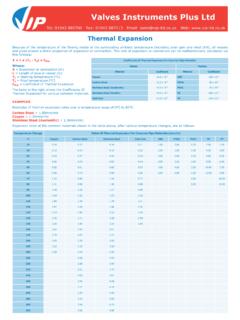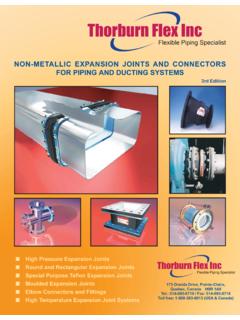Transcription of Rigid Nonmetallic Conduit Expansion and …
1 Rigid Nonmetallic Conduit Expansion and Contraction Temperature Considerations for Rigid Nonmetallic Conduit Compensation for Linear Expansion Like all construction materials, PVC will expand or contract with variations in temperatures. The coefficient of linear Expansion in PVC Conduit is x 10-5 F as compared to x 10-5 for aluminum and x 10-5 for steel. An Expansion fitting is needed whenever the change in length due to temperature variation will be 1/4 in or greater per of the NEC. Add 30 F to the estimated temperature range when Conduit is installed in direct sunlight to allow for radiant heating. An Expansion fitting consists of two sections, one telescoping inside another. When installing Expansion fittings, alignment of piston and barrel is important.
2 Be sure to mount Expansion fitting level for best performance. For a vertical run, the Expansion fitting must be installed close to the top of the run with the barrel jointing down, in order that rain water does not run into the opening. The lower end of the Conduit run must be secured at the bottom so that any length change due to temperature variation will result in an upward movement. Expansion Characteristics of PVC Rigid Nonmetallic Conduit Coefficient of Thermal Expansion = x 10-5 F. Temperature Length Change Temperature Length Change Temperature Length Change Temperature Length Change Change ( F) inches/100 Ft. of Change ( F) inches/100 Ft. of Change ( F) inches/100 Ft. of Change ( F) inches/100 Ft. of PVC Conduit PVC Conduit PVC Conduit PVC Conduit 5 55 105 155 10 60 110 160 15 65 115 165 20 70 120 170 25 1 75 3 125 175 30 80 130 180 35 85 135 185 40 90 140 190 45 95 145 195 50 2 100 150 200 23240 Chagrin Blvd Suite 405 Cleveland, OH 44122 216-464-3400 1.
3 Rigid Nonmetallic Conduit Expansion and Contraction Determine the Piston Opening The Expansion joint must be installed to allow both Expansion and contraction of the Conduit run. The correct piston opening for any installation condition should use the following formula: Where: O = Piston opening (in.). T max = Maximum anticipated temperature of Conduit ( F). T inst. = Temperature of Conduit at time of installation ( F). T = Total change in temperature of Conduit ( F). E = Expansion allowance built into each Expansion fitting (in.). Example 380 ft. of Conduit is to be installed on the outside of a building exposed to the sun in a single straight run. It is expected that the Conduit will vary in temperature from 0 F in the winter to 140 F in the summer (this includes the 30 F for radiant heating from the sun.)
4 The installation is to be made at a Conduit temperature of 90 F. From the table, a 140 F. temperature change will cause a in. length change in 100 ft. of Conduit . The total change for this example is " x = " which should be rounded to 22". The number of Expansion fittings will be 22" fitting range (4" for Prime Conduit trade sizes 1/2" through 1-1/2", and 8" for sizes 2" through 6".) The fitting should be placed at 63 ft. intervals (380 6). The proper piston setting at the time of installation is calculated as explained above. Insert the piston into the barrel to the maximum depth. Place a mark on the piston at the end of the barrel. To properly set the piston, pull the piston out of the barrel to correspond to the in. calculated above.
5 Summary 1. Anticipate Expansion and contraction of PVC Conduit in aboveground, exposed installation. 2. Use an Expansion fitting when length change due to temperature variation will be 1/4" or greater per of the NEC. 3. PVC Conduit expands " for each 100 feet of run and a 100 F temperature change. 4. Align Expansion fitting with the Conduit run to prevent binding. 5. Follow the instructions to set the piston opening. 6. Rigidly fix the outer barrel of the Expansion fitting so it cannot move. Mount the Conduit connected to the piston loosely enough to allow the Conduit to move as the temperature changes. 23240 Chagrin Blvd Suite 405 Cleveland, OH 44122 216-464-3400 2.
